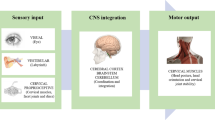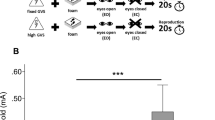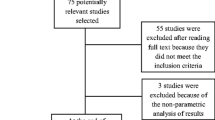Abstract
The phenomenon of reproduction of the series of passive single-joint movements in the tested arm by the contralateral arm just in the course of passive movements with no visual control was studied in 35 healthy subjects and 13 post-stroke patients in order to develop a new method for objective assessment of sense of the arm motion for the detection of proprioceptive deficit and for monitoring of the changes in proprioception during rehabilitation. We examined the reproduction of flexion–extension at the elbow and wrist joints, abduction–adduction at the wrist joint and the forearm pronation–supination in both right and left arms in healthy subjects and in the affected arm in post-stroke patients. Displacements of the angles in the tested joint and a homonymous joint of the other arm were acquired by means of video recording system, goniometers, or 9-DoF inertional-magnetometric sensors. Qualitative and quantitative indicators were evaluated to assess the similarity of the passive and active movements. It has been found that the healthy subjects are able to actively reproduce the repeated passive movements at different joints of either the left or right tested arm almost simultaneously and with quite accurate reproduction of an amplitude and shape of movement. At the same time, most of post-stroke patients reproduce movements either with qualitative errors demonstrating incorrect location or wrong estimation of direction or number of repeated test movements, or with significant reduction of accuracy (increased latency or shape distortion). We proposed a method for the assessment of movement proprioception at individual joints. The procedure is easy and convenient for both physicians and patients. It does not require special heavy equipment and can easily be performed under different conditions in a wide range of patients.
Similar content being viewed by others
References
Proske, U. and Gandevia, S.C., The kinaesthetic senses, J. Physiol., 2009, vol. 587, no. 17, p. 4139.
Kozlovskaya, I.B., Afferentnyi kontrol’ proizvol’nykh dvizhenii (Afferent Control of Voluntary Movements), Moscow: Nauka, 1976.
Ostry, D.J., Darainy, M., Mattar, A.A., et al., Somatosensory plasticity and motor learning, J. Neurosci., 2010, vol. 30, p. 5384.
Dukelow, S.P., Herter, T.M., Moore, K.D., et al., Quantitative assessment of limb position sense following stroke, Neurorehabil. Neural Repair., 2010, vol. 24, no. 2, p.178.
Schabrun, S.M. and Hillier, S., Evidence for the retraining of sensation after stroke: a systematic review, Clin. Rehabil., 2009, vol. 23, p.27.
Sullivan, J.E. and Hedman, L.D., Sensory dysfunction following stroke: incidence, significance, examination, and intervention, Top Stroke Rehabil., 2008, vol. 15, p.200.
Coupar, F., Pollock, A., Rowe, P., et al., Predictors of upper limb recovery after stroke: a systematic review and meta-analysis, Clin. Rehabil., 2012, vol. 26, p.291.
Meyer, S., Karttunen, A.H., Thijs, V., et al., How do somatosensory deficits in the arm and hand relate to upper limb impairment, activity, and participation problems after stroke? A systematic review, Phys. Ther., 2014, vol. 94, no. 9, p. 1220.
Suetterlin, K.J. and Sayer, A.A., Proprioception: where are we now? A commentary on clinical assessment, changes across the life course, functional implications and future interventions, Age Ageing, 2013, vol. 43, p.313.
Stillman, B.C., An investigation of the clinical assessment of joint position sense, PhD Thesis, Parkville: Univ. of Melbourne, 2000.
Luriya, A.R., Vysshie korkovye funktsii cheloveka i ikh narusheniya pri lokal’nykh povrezhdeniyakh mozga (Higher Cortical Functions of a Person and their Failure Caused by Local Brain Damage), Moscow: Mosk. Gos. Univ., 1962.
Radau, Yu.V., Shchedrina, M.A., Novikov, A.V., and Komkova, O.V., RF Patent 2198587, Byull. Izobret., 2003, no.5.
Paillard, J. and Drouchon, M., Active and passive movements in the calibration of position sense, in The Neuropsychology of Spatially Oriented Behavior, Freedman, S.J., Ed., Homewood: Dorsey Press, 1968, ch. 3, p.37.
Connell, L.A. and Tyson, S.F., Measures of sensation in neurological conditions: a systematic review, Clin. Rehabil., 2012, vol. 26, no. 1, p.68.
Fugl-Meyer, A.R., Jaasko, L., Leyman, I., et al., The post-stroke hemiplegic patient 1. A method for evaluation of physical performance, Scand. J. Rehabil. Med., 1975, vol. 7, p.13.
Lincoln, N., Crow, J., Jackson, J., et al., The unreliability of sensory assessments, Clin. Rehabil., 1991, vol. 5, p.273.
Semrau, J.A., Herter, T.M., Scott, S.H., and Dukelow, S.P., Robotic identification of kinesthetic deficits after stroke, Stroke, 2013, vol. 44, p. 3414.
Findlater, S.E., Desai, J.A., Semrau, J.A., et al., Central perception of position sense involves a distributed neural network—evidence from lesion-behavior analyses, Cortex, 2016, vol. 79, p.42.
Oldfield, R.C., The assessment and analysis of handedness: the Edinburgh inventory, Neuropsychologia, 1971, vol. 9, no. 1, p.97.
Stakhovskaya, L.V. and Kotov, S.V., Stroke, in Rukovodstvo dlya vrachei (Handbook for Physicians), Moscow: Med. Inf. Agentstvo, 2014.
Selionov, V.A., Solopova, I.A., Zhvansky, D.S., and Grishin, A.A., Abnormalities of mutual influences of the upper and lower limbs after a stroke, Hum. Physiol., 2012, vol. 38, no. 3, p.276.
Goble, D., Proprioceptive acuity assessment via joint position matching: from basic science to general practice, Phys. Ther., 2010, vol. 90, no. 8, p. 1176.
Semrau, J.A., Wang, J.C., Herter, T.M., et al., Relationship between visuospatial neglect and kinesthetic deficits after stroke, Neurorehabil. Neural Repair., 2015, vol. 29, no. 4, p.318.
Marsden, C.D., Merton, P.A., and Morton, H.B., Human postural responses, Brain, 1981, vol. 104, p.513.
Hammond, P.H., The influence of prior instruction to the subject on an apparently involuntary neuro-muscular response, J. Physiol. (Oxford), 1956, vol. 132, p.17.
Naito, E., Roland, P.E., Grefkes, C., et al., Dominance of the right hemisphere and role of area 2 in human kinesthesia, J. Neurophysiol., 2005, vol. 93, p. 1020.
Naito, E., Morita, T., and Amemiya, K., Body representations in the human brain revealed by kinesthetic illusions and their essential contributions to motor control and corporeal awareness, Neurosci. Res., 2016, vol. 104, p. 16.
Author information
Authors and Affiliations
Corresponding author
Additional information
Original Russian Text © O.G. Pavlova, V.Y. Roschin, M.V. Sidorova, V.A. Selionov, M.A. Kulikov, A.N. Staritsyn, 2018, published in Fiziologiya Cheloveka, 2018, Vol. 44, No. 4, pp. 84–95.
Rights and permissions
About this article
Cite this article
Pavlova, O.G., Roschin, V.Y., Sidorova, M.V. et al. Method for Qualitative and Quantitative Assessment of Proprioceptive Perception of Single-joint Arm Movements. Hum Physiol 44, 445–455 (2018). https://doi.org/10.1134/S0362119718040126
Received:
Published:
Issue Date:
DOI: https://doi.org/10.1134/S0362119718040126




